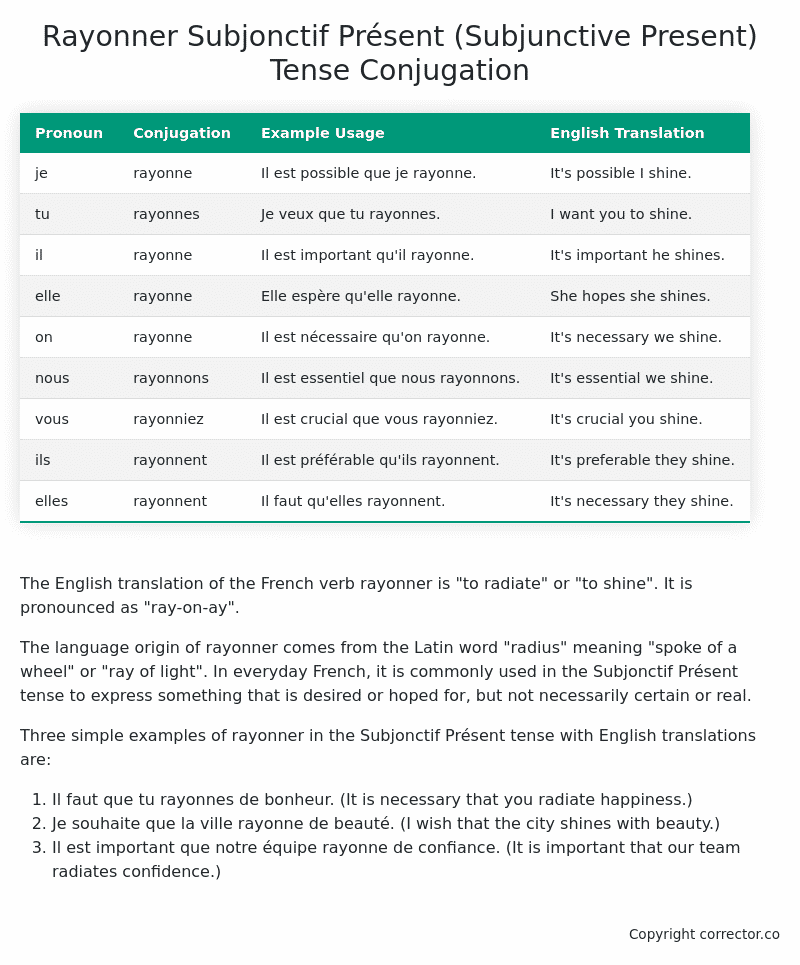Subjonctif Présent (Subjunctive Present) Tense Conjugation of the French Verb rayonner
Introduction to the verb rayonner
The English translation of the French verb rayonner is “to radiate” or “to shine”. It is pronounced as “ray-on-ay”.
The language origin of rayonner comes from the Latin word “radius” meaning “spoke of a wheel” or “ray of light”. In everyday French, it is commonly used in the Subjonctif Présent tense to express something that is desired or hoped for, but not necessarily certain or real.
Three simple examples of rayonner in the Subjonctif Présent tense with English translations are:
- Il faut que tu rayonnes de bonheur. (It is necessary that you radiate happiness.)
- Je souhaite que la ville rayonne de beauté. (I wish that the city shines with beauty.)
- Il est important que notre équipe rayonne de confiance. (It is important that our team radiates confidence.)
Table of the Subjonctif Présent (Subjunctive Present) Tense Conjugation of rayonner
| Pronoun | Conjugation | Example Usage | English Translation |
|---|---|---|---|
| je | rayonne | Il est possible que je rayonne. | It’s possible I shine. |
| tu | rayonnes | Je veux que tu rayonnes. | I want you to shine. |
| il | rayonne | Il est important qu’il rayonne. | It’s important he shines. |
| elle | rayonne | Elle espère qu’elle rayonne. | She hopes she shines. |
| on | rayonne | Il est nécessaire qu’on rayonne. | It’s necessary we shine. |
| nous | rayonnons | Il est essentiel que nous rayonnons. | It’s essential we shine. |
| vous | rayonniez | Il est crucial que vous rayonniez. | It’s crucial you shine. |
| ils | rayonnent | Il est préférable qu’ils rayonnent. | It’s preferable they shine. |
| elles | rayonnent | Il faut qu’elles rayonnent. | It’s necessary they shine. |
Other Conjugations for Rayonner.
Le Present (Present Tense) Conjugation of the French Verb rayonner
Imparfait (Imperfect) Tense Conjugation of the French Verb rayonner
Passé Simple (Simple Past) Tense Conjugation of the French Verb rayonner
Passé Composé (Present Perfect) Tense Conjugation of the French Verb rayonner
Futur Simple (Simple Future) Tense Conjugation of the French Verb rayonner
Futur Proche (Near Future) Tense Conjugation of the French Verb rayonner
Plus-que-parfait (Pluperfect) Tense Conjugation of the French Verb rayonner
Passé Antérieur (Past Anterior) Tense Conjugation of the French Verb rayonner
Futur Antérieur (Future Anterior) Tense Conjugation of the French Verb rayonner
Subjonctif Présent (Subjunctive Present) Tense Conjugation of the French Verb rayonner (this article)
Subjonctif Passé (Subjunctive Past) Tense Conjugation of the French Verb rayonner
Subjonctif Imparfait (Subjunctive Imperfect) Tense Conjugation of the French Verb rayonner
Subjonctif Plus-que-parfait (Subjunctive Pluperfect) Tense Conjugation of the French Verb rayonner
Conditionnel Présent (Conditional Present) Tense Conjugation of the French Verb rayonner
Conditionnel Passé (Conditional Past) Tense Conjugation of the French Verb rayonner
L’impératif Présent (Imperative Present) Tense Conjugation of the French Verb rayonner
L’infinitif Présent (Infinitive Present) Tense Conjugation of the French Verb rayonner
Struggling with French verbs or the language in general? Why not use our free French Grammar Checker – no registration required!
Get a FREE Download Study Sheet of this Conjugation 🔥
Simply right click the image below, click “save image” and get your free reference for the rayonner Subjonctif Présent tense conjugation!

Rayonner – About the French Subjonctif Présent (Subjunctive Present) Tense
Formation of the Subjonctif Présent
Common Everyday Usage Patterns
Interactions with Other Tenses
Summary
I hope you enjoyed this article on the verb rayonner. Still in a learning mood? Check out another TOTALLY random French verb conjugation!


